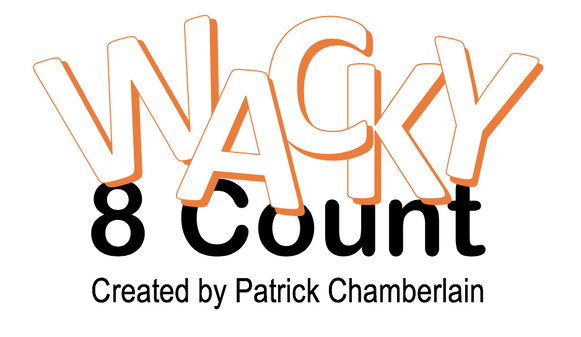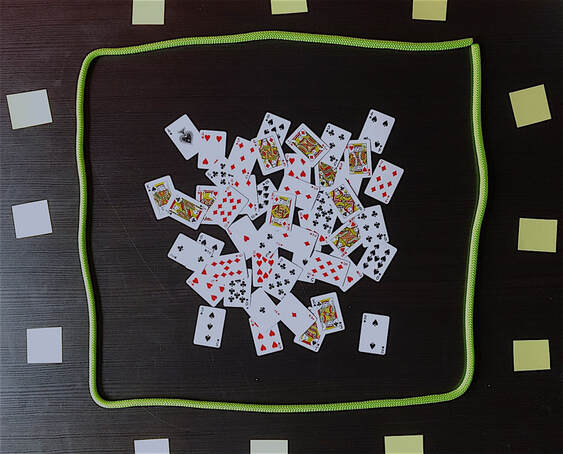Chris Cavert, Ed.D.
|
SUB-TITLE CONTEST I was trying to come up with a catchy (and fitting) sub-title for this one like, 'You're Kidding Me!' or 'Mo Cardio' but couldn't decide. So, let's have a little contest. Check out the videos, get a little experience with any of the challenges (be careful!!), then leave your sub-title suggestion in the Comments. We'll keep submissions open until the end of June, 2020. Patrick gets to pick the winner. The winner will receive a FREE download of choice from the FUNdoing Store. Be careful out there. If you've been sitting around a lot lately, don't try all four challenges in one day!!
I so love it when we get a share! This one is from Patrick Chamberlain. Inspired by his colleague David Adlard and a couple of videos in the April Challenge Week FUNdoing Blog post (Six Count & Double Jump Six Count), Patrick made up his own challenge (well, four challenges actually). Super fun and 'Wacky' challenging! Thank You Patrick! You're amazing. (Be careful out there my friends!!)
Keep me posted!
Chris Cavert, Ed.D.
0 Comments
This is another activity for in-person team building while safely distancing. (Circle Around - the last FUNdoing blog post - is another safe distancing activity to consider.) Request: If you have an activity in mind that can be done while 'safe distancing' please let us know through the Comments so we can all be ready for the transition.
Set Up
Not In the Cards will probably play well with 8 to 12 participants (so far, this one is just an idea). Using a 50-foot activity rope (about that length), set down a square or circle (or whatever shape you want, really) and put out a game spots, one for each participant, around the outside of the shape - set the spots six feet apart from each other (or whatever your distancing LOPs require). (The Set Up above is for 12 participants.) Setting out 48 Cards: In the picture above, I've set out 48 cards so there are a bunch overlapping - this could be a more challenging set up? An easier array (?) would be to not overlap any cards. Before laying down the cards, take out one card from each suit and set them aside - you'll need to do some prep with these four cards in a moment. If you plan to overlap, be sure to leave enough of each card showing so the rank and suit can be identified. The other 4 Cards: The four cards you removed from the deck are needed for the second half of the challenge ahead. You need to come up with four mathematical formulas with these numbers that result in (the sums are) different numbers - keep these formulas with you during the activity. For example, say you pulled out a 3, 5, 8 & 10. One number you could use is 26 - if you add the four numbers together. Now, you need three other formulas with these same four numbers. Your others could be: 72, 13 & 10 (Challenge: Find the formulas I used to get these numbers?) (This part of the challenge was inspired by the activity, Get 20, from Playing with a Full Deck by Michelle Cummings.) Before you can play, you'll need some paper and and markers (you could also use four small white boards and appropriate markers for these). If you have access to clip boards, grab four of those as well. Take four pieces of paper and the four 'sum' numbers you have figured (using the four cards you removed from the deck). Write one number on each piece of paper - a different number on each piece. (Using the example numbers above, one piece of paper will have the number 26, another piece will have 72, another 13, and the fourth piece of paper will have a 10.) Place theses papers nearby, separated from each other, along with a marker (recently sterilized) for each piece of paper. (Make sure you are following your safety protocols for using equipment/supples - if needed.)
Procedures for Play
Facilitation Notes
To reiterate, this activity is still conceptual in nature - no play data yet. So, help me think through this. One of the main facilitated objectives for this activity is to see how the group manages to work through the challenges while safely distancing (based on what you have set up with the group about this). These are some of the questions I'm thinking I could ask a group about this experience:
Considerations
Let us know what you think. Let's make this one better together. Share in the Comments or send me (Chris) and email.
All the best! Chris Cavert, Ed.D. |
Team Building Activities sent to your email every two weeks!
FREE Processing Activity just for signing up!
Processing for Beginners
FREE Mini-Course Some Team Building Tools at the STORE!

Blog AuthorDr. Chris Cavert is an internationally known author, speaker, and trainer in the area of adventure-based activity programming and its relation to community and pro-social behavior development. Blog PurposeThis blog is a space for hands-on programable fun - energetic activities and ideas that can be used as a means to bring people together; activities and ideas we as educators can add to our social development curriculums. Categories
All
Archives
June 2024
|







 RSS Feed
RSS Feed